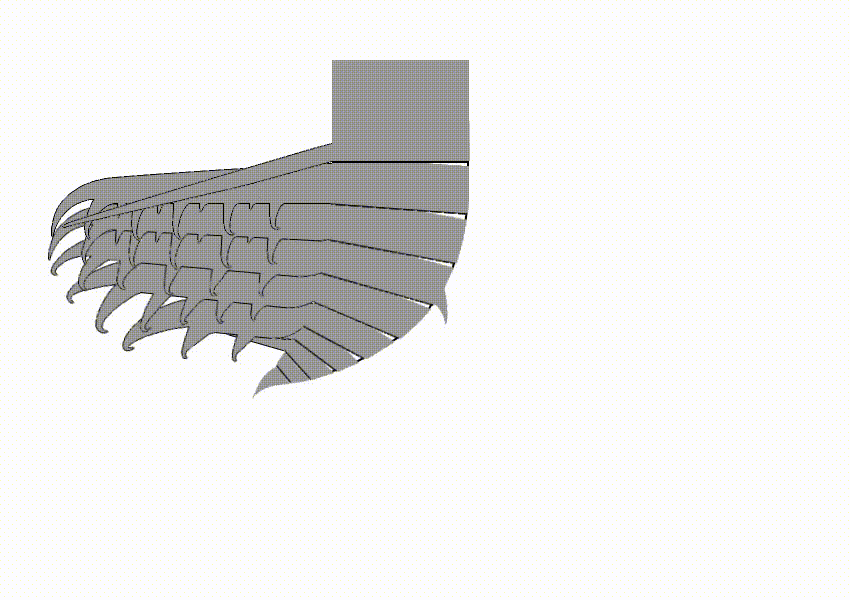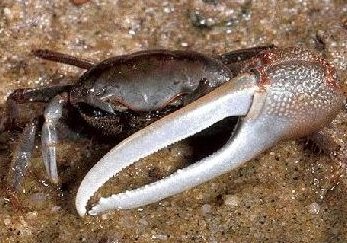|
Amplectobeluidae
''Amplectobeluidae'' is a clade of Cambrian radiodonts. Definition In 2014, ''Amplectobeluidae'' was defined as the most inclusive clade including '' Amplectobelua symbrachiata'' but not ''Anomalocaris canadensis'', ''Tamisiocaris borealis'', or ''Hurdia victoria''. Description Amplectobeluids could be recognized by frontal appendages with well-developed first distal endite, which forming a pincer-like structure that presumably better suited for a grasping function. Complete body fossils of amplectobeluids are only known by ''Amplectobelua'' and ''Lyrarapax'', both showing combination of characters resembling ''Anomalocaris'' (i.e. streamlined body; small head with ovoid sclerites; well-developed swimming flaps; a pair of caudal furcae). Another distinctive features only known in amplectobeluid genera were pairs of gnathobase-like structures (known by ''Amplectobelua'' and ''Ramskoeldia''), or an oral cone with combination of tetraradial arrangement and scale-like nodes (known ... [...More Info...] [...Related Items...] OR: [Wikipedia] [Google] [Baidu] |
Radiodonta
Radiodonta is an extinct Order (biology), order of stem-group arthropods that was successful worldwide during the Cambrian period. They may be referred to as radiodonts, radiodontans, radiodontids, anomalocarids, or anomalocaridids, although the last two originally refer to the family Anomalocarididae, which previously included all species of this order but is now restricted to only a few species. Radiodonts are distinguished by their distinctive frontal appendages, which are morphologically diverse and used for a variety of functions. Radiodonts included the earliest large predators known, but they also included sediment sifters and filter feeders. Some of the most famous species of radiodonts are the Cambrian taxa ''Anomalocaris, Anomalocaris canadensis'', ''Hurdia, Hurdia victoria'', ''Peytoia nathorsti'', ''Titanokorys gainesii, Titanokorys gainessii, Cambroraster, Cambroraster falcatus'' and ''Amplectobelua, Amplectobelua symbrachiata'', the Ordovician ''Aegirocassis, Aegiroca ... [...More Info...] [...Related Items...] OR: [Wikipedia] [Google] [Baidu] |
Ramskoeldia
''Ramskoeldia'' is a genus of amplectobeluid radiodont described in 2018. It was the second genus of radiodont found to possess gnathobase-like structures (abbreviated as GLS) and an atypical oral cone after '' Amplectobelua''. It was discovered in the Chengjiang biota of China, the home of numerous radiodontids such as '' Amplectobelua'' and ''Lyrarapax''. Morphology ''Ramskoeldia'' is known only from a few frontal appendages, gnathobase-like structures (GLSs), disarticulated smooth and tuberculated plates interpreted as parts of their oral cones, as well as fragments of body flaps and head carapace complex. The frontal appendage of ''Ramskoeldia'' is composed of 16 podomeres (3 shaft podomeres and 13 distal articulated region podomeres), with endites of podomeres 4 to at least podomere 12 bearing prominent auxiliary spines. The endites of podomere 4 (first podomere of distal articulated region) is the largest compared to other endites, but not extremely enlarged like those ... [...More Info...] [...Related Items...] OR: [Wikipedia] [Google] [Baidu] |
Amplectobelua
''Amplectobelua'' (meaning "embracing beast") is an extinct genus of late Early Cambrian amplectobeluid radiodont, a group of stem arthropods that mostly lived as free-swimming predators during the first half of the Paleozoic Era. Anatomy The body structures other than frontal appendages are only known from the type species ''Amplectobelua symbrachiata''. Like other radiodonts, ''Amplectobelua'' had a pair of jointed frontal appendages, a head covered by dorsal and lateral sclerites (the latter had been misinterpreted as huge eyes), a limbless body with dorsal gills (setal blades), and a series of flaps on both sides that extended along the length of its body. ''Amplectobelua'' had a specialized frontal appendage, in which it has a distinct 3-segmented shaft region and 12-segmented distal articulated region, and the spine on the fourth segment (first segment of distal articulated region) hooked forward to oppose the tip of the appendage, allowing it to grasp prey like a ... [...More Info...] [...Related Items...] OR: [Wikipedia] [Google] [Baidu] |
Lyrarapax
'' Lyrarapax'' is a radiodont genus of the family Amplectobeluidae that lived in the early Cambrian period 520 million years ago. Its neural tissue indicates that the radiodont frontal appendage is protocerebral, resolving parts of the arthropod head problem and showing that the frontal appendage is homologous to the antennae of Onychophorans and labrum of euarthropods. Its fossilized remains were found in Yunnan Yunnan , () is a landlocked province in the southwest of the People's Republic of China. The province spans approximately and has a population of 48.3 million (as of 2018). The capital of the province is Kunming. The province borders the C ... in southwestern China. A second species was described in 2016, differing principally in the morphology of its frontal appendages. Taxonomy The scientific name "''Lyrarapax''" is a compound word of the Latin "lyra" (lyre) and "rapax" (predator), and is named after the outline of the body of this genus, which resembles a ... [...More Info...] [...Related Items...] OR: [Wikipedia] [Google] [Baidu] |
Anomalocaris
''Anomalocaris'' ("unlike other shrimp", or "abnormal shrimp") is an extinct genus of Radiodonta, radiodont, an Order (biology), order of early-diverging stem-group arthropods. The first fossils of ''Anomalocaris'' were discovered in the ''Ogygopsis'' Shale of the Stephen Formation in British Columbia, Canada by Joseph Frederick Whiteaves, with more examples found by Charles Doolittle Walcott in the Burgess Shale unit of the Stephen Formation. Other closely related fossils have been found in the older Emu Bay Shale of Australia, as well as possibly elsewhere. Originally several fossilized parts discovered separately (the mouth, frontal appendages and trunk) were thought to be three separate creatures, a misapprehension corrected by Harry B. Whittington and Derek Briggs in a 1985 journal article. With a body length close to 40 centimetres, ''A. canadensis'' is thought to be one of the earliest examples of an apex predator, though others have been found in older Cambrian lagerstätte ... [...More Info...] [...Related Items...] OR: [Wikipedia] [Google] [Baidu] |
Anomalocaridids
''Anomalocaris'' ("unlike other shrimp", or "abnormal shrimp") is an extinct genus of radiodont, an order of early-diverging stem-group arthropods. The first fossils of ''Anomalocaris'' were discovered in the ''Ogygopsis'' Shale of the Stephen Formation in British Columbia, Canada by Joseph Frederick Whiteaves, with more examples found by Charles Doolittle Walcott in the Burgess Shale unit of the Stephen Formation. Other closely related fossils have been found in the older Emu Bay Shale of Australia, as well as possibly elsewhere. Originally several fossilized parts discovered separately (the mouth, frontal appendages and trunk) were thought to be three separate creatures, a misapprehension corrected by Harry B. Whittington and Derek Briggs in a 1985 journal article. With a body length close to 40 centimetres, ''A. canadensis'' is thought to be one of the earliest examples of an apex predator, though others have been found in older Cambrian lagerstätten deposits. Discovery ''A ... [...More Info...] [...Related Items...] OR: [Wikipedia] [Google] [Baidu] |
Clade
A clade (), also known as a monophyletic group or natural group, is a group of organisms that are monophyletic – that is, composed of a common ancestor and all its lineal descendants – on a phylogenetic tree. Rather than the English term, the equivalent Latin term ''cladus'' (plural ''cladi'') is often used in taxonomical literature. The common ancestor may be an individual, a population, or a species (extinct or extant). Clades are nested, one in another, as each branch in turn splits into smaller branches. These splits reflect evolutionary history as populations diverged and evolved independently. Clades are termed monophyletic (Greek: "one clan") groups. Over the last few decades, the cladistic approach has revolutionized biological classification and revealed surprising evolutionary relationships among organisms. Increasingly, taxonomists try to avoid naming taxa that are not clades; that is, taxa that are not monophyletic. Some of the relationships between organisms ... [...More Info...] [...Related Items...] OR: [Wikipedia] [Google] [Baidu] |
Cambrian
The Cambrian Period ( ; sometimes symbolized C with bar, Ꞓ) was the first geological period of the Paleozoic Era, and of the Phanerozoic Eon. The Cambrian lasted 53.4 million years from the end of the preceding Ediacaran Period 538.8 million years ago (mya) to the beginning of the Ordovician Period mya. Its subdivisions, and its base, are somewhat in flux. The period was established as "Cambrian series" by Adam Sedgwick, who named it after Cambria, the Latin name for 'Cymru' (Wales), where Britain's Cambrian rocks are best exposed. Sedgwick identified the layer as part of his task, along with Roderick Murchison, to subdivide the large "Transition Series", although the two geologists disagreed for a while on the appropriate categorization. The Cambrian is unique in its unusually high proportion of sedimentary deposits, sites of exceptional preservation where "soft" parts of organisms are preserved as well as their more resistant shells. As a result, our understanding of the Ca ... [...More Info...] [...Related Items...] OR: [Wikipedia] [Google] [Baidu] |
Tamisiocaris
''Tamisiocaris'' (from Latin ''tamisium'', sieve, and Greek ''karis'', crab, shrimp) is a radiodont genus initially only known from frontal appendages from the Buen Formation in Sirius Passet. Further specimens revealed that the frontal appendages were segmented and bore densely-packed auxiliary spines, which were adapted to suspension feeding in a manner analogous to modern baleen whales Baleen whales (systematic name Mysticeti), also known as whalebone whales, are a parvorder of carnivorous marine mammals of the infraorder Cetacea (whales, dolphins and porpoises) which use keratinaceous baleen plates (or "whalebone") in the .... See also * References {{Taxonbar, from=Q2391651 Anomalocaridids Prehistoric arthropod genera Cambrian arthropods Cambrian Greenland Fossils of Greenland Sirius Passet fossils Buen Formation Fossil taxa described in 2010 Cambrian genus extinctions ... [...More Info...] [...Related Items...] OR: [Wikipedia] [Google] [Baidu] |
Hurdia
''Hurdia'' is an extinct genus of hurdiid radiodont that lived 505 million years ago during the Cambrian Period. As a radiodont like ''Peytoia'' and ''Anomalocaris'', it is part of the ancestral lineage that led to euarthropods. Description ''Hurdia'' was one of the largest organisms in the Cambrian oceans, ''H. victoria'' reached approximately in length, while ''H. triangulata'' reached up to just . Its head bore a pair of rake-like frontal appendages which shovelled food into its pineapple-ring-like mouth (oral cone). Like other hurdiids, ''Hurdia'' bore a large frontal carapace protruding from its head composed of three sclerites: a central component known as the H-element and two lateral components known as P-elements. The function of this organ remains mysterious; it cannot have been protective as there was no underlying soft tissue. Originally, it is estimated that body flaps ran along the sides of the organisms, from which large gills were suspended. However, anatomy of ... [...More Info...] [...Related Items...] OR: [Wikipedia] [Google] [Baidu] |
Chela (organ)
A chela ()also called a claw, nipper, or pinceris a pincer (biology), pincer-like organ at the end of certain limbs of some arthropods. The name comes from Ancient Greek , through New Latin '. The plural form is chelae. Legs bearing a chela are called chelipeds. Another name is ''claw'' because most chelae are curved and have a sharp point like a claw. Chelae can be present at the tips of arthropod legs as well as their pedipalps. Chelae are distinct from spider chelicerae in that they do not contain venomous glands and cannot distribute venom. See also * Pincer (biology) * Pincer (tool) References Arthropod anatomy {{Arthropod-anatomy-stub ... [...More Info...] [...Related Items...] OR: [Wikipedia] [Google] [Baidu] |
Parker Formation
Parker may refer to: Persons * Parker (given name) * Parker (surname) Places Place names in the United States *Parker, Arizona *Parker, Colorado *Parker, Florida *Parker, Idaho *Parker, Kansas *Parker, Missouri *Parker, North Carolina *Parker, Pennsylvania *Parker, South Carolina *Parker, South Dakota *Parker, Texas in Collin County * Parker, Johnson County, Texas * Parker, Washington *Parker City, Indiana *Parker County, Texas *Parker Dam, at Lake Havasu on the Colorado River between Arizona and California *Parker Road (DART station), a light rail terminal on Parker Road in Plano, Texas *Parker School, Montana *Parker Strip, Arizona *Parker Township, Marshall County, Minnesota *Parker Township, Morrison County, Minnesota *Parker Township, Butler County, Pennsylvania *Parker Center, a former police building in Los Angeles Elsewhere * C. W. Parker Carousel, a Burnaby Village Museum exhibit in British Columbia, Canada * Mount Parker (Philippines), a Mindanao island volcano of the Ph ... [...More Info...] [...Related Items...] OR: [Wikipedia] [Google] [Baidu] |





